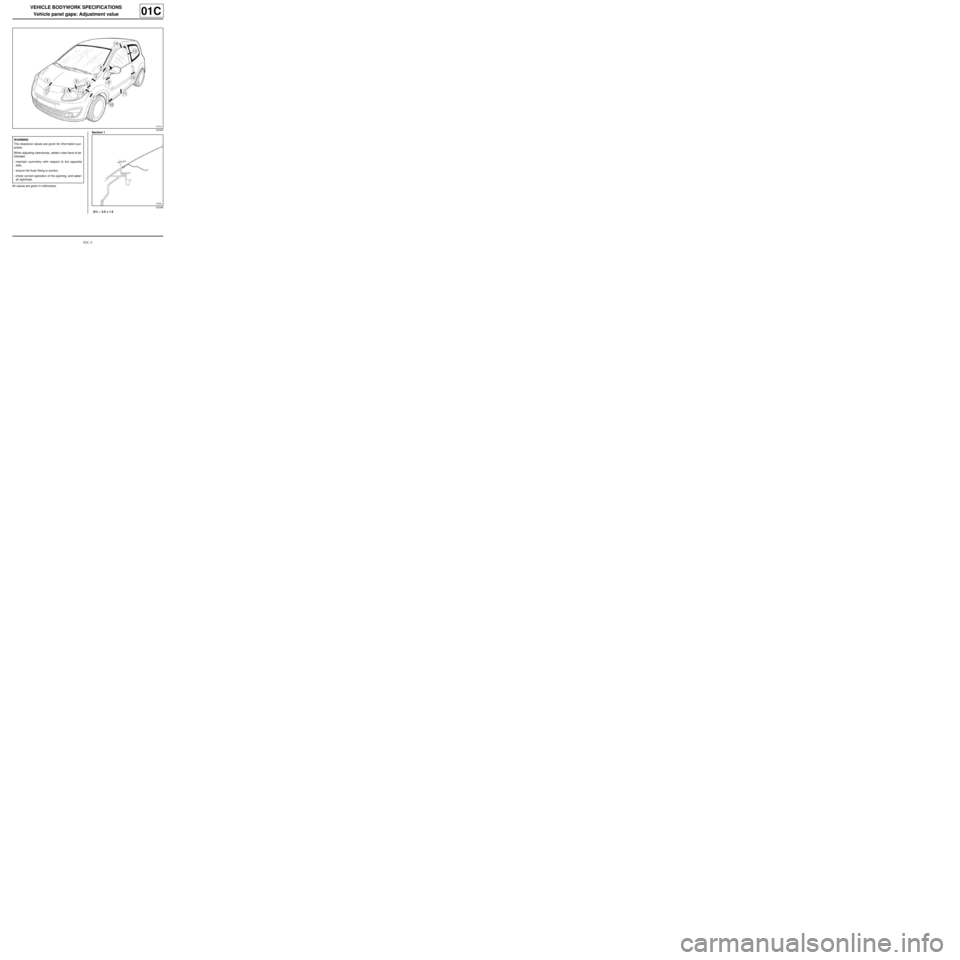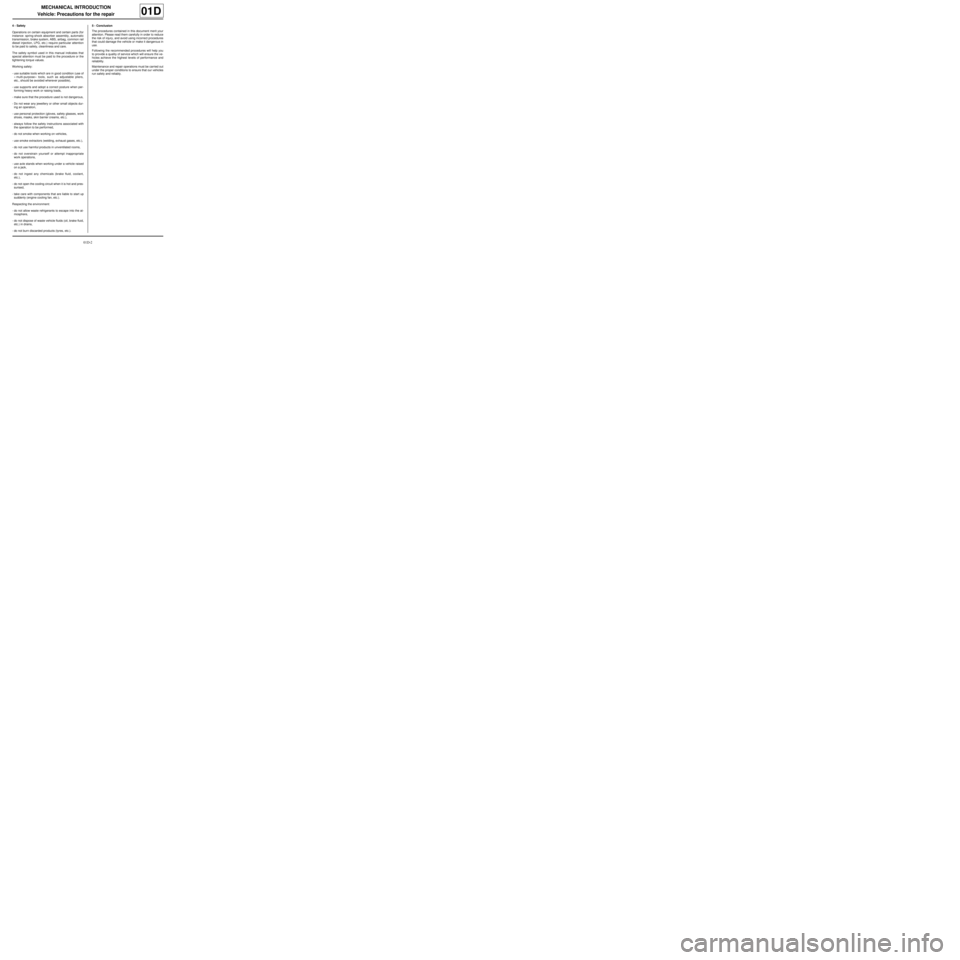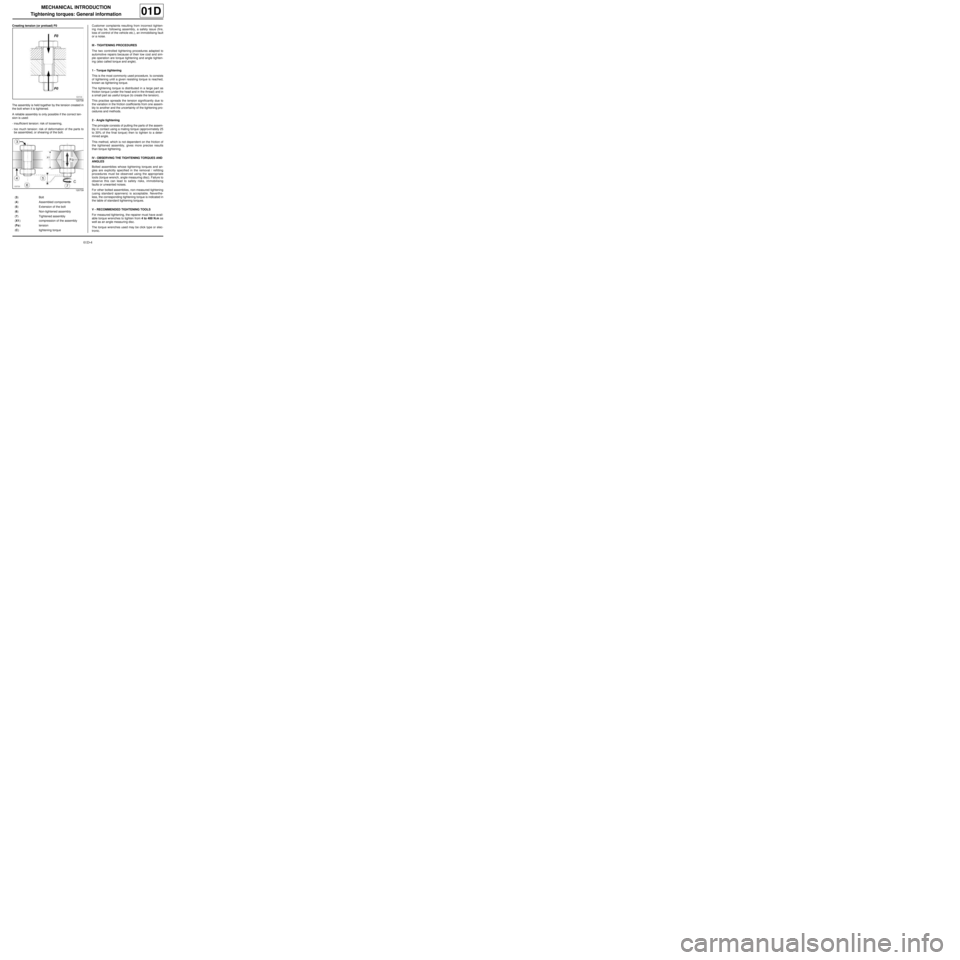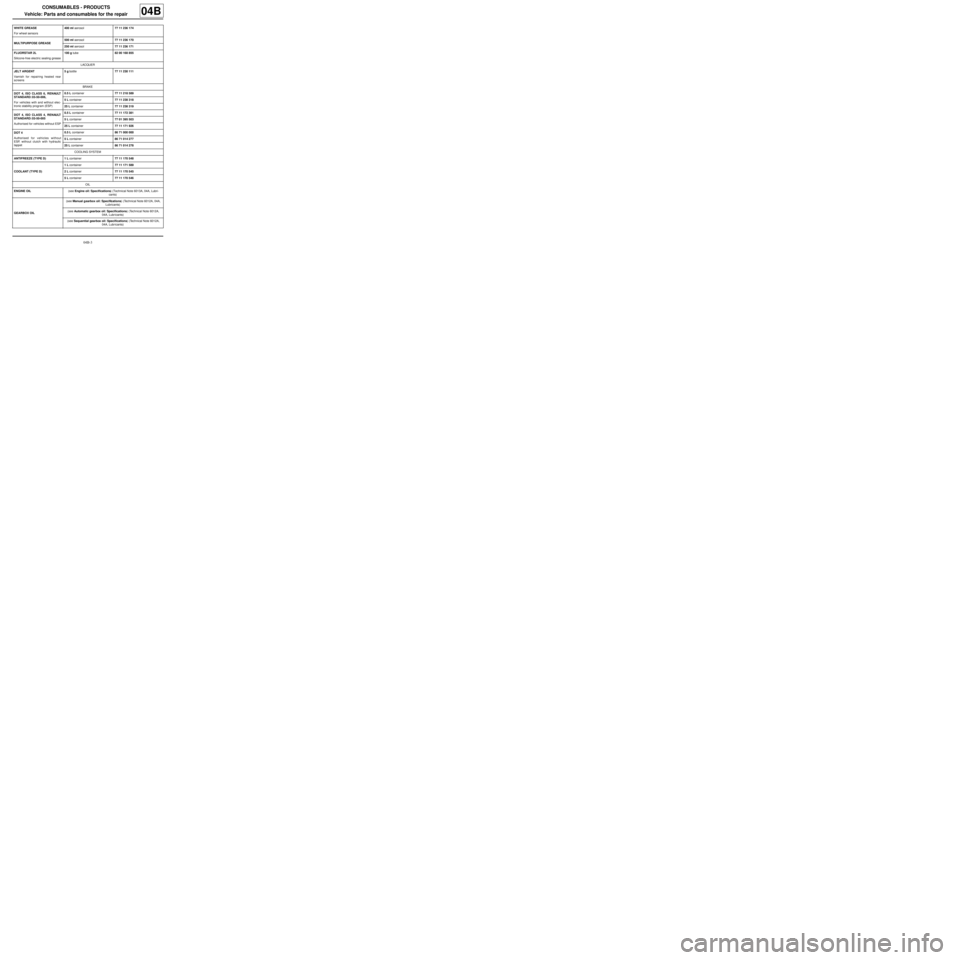ESP RENAULT TWINGO RS 2009 2.G General Vehicle Information Workshop Manual
[x] Cancel search | Manufacturer: RENAULT, Model Year: 2009, Model line: TWINGO RS, Model: RENAULT TWINGO RS 2009 2.GPages: 46
Page 7 of 46

01C-3
VEHICLE BODYWORK SPECIFICATIONS
Vehicle panel gaps: Adjustment value
01C
All values are given in millimetres.Section 1
(X1) = 3.5 ±± ± ±
1.5
120453
WARNING
The clearance values are given for information pur-
poses.
When adjusting clearances, certain rules have to be
followed:
-maintain symmetry with respect to the opposite
side,
-ensure the flush fitting is correct,
-check correct operation of the opening, and water/
air-tightness.
120385
Page 15 of 46

01D-2
MECHANICAL INTRODUCTION
Vehicle: Precautions for the repair
01D
4 - Safety
Operations on certain equipment and certain parts (for
instance: spring-shock absorber assembly, automatic
transmission, brake system, ABS, airbag, common rail
diesel injection, LPG, etc.) require particular attention
to be paid to safety, cleanliness and care.
The safety symbol used in this manual indicates that
special attention must be paid to the procedure or the
tightening torque values.
Working safely:
-use suitable tools which are in good condition (use of
« multi-purpose » tools, such as adjustable pliers,
etc., should be avoided wherever possible),
-use supports and adopt a correct posture when per-
forming heavy work or raising loads,
-make sure that the procedure used is not dangerous,
-Do not wear any jewellery or other small objects dur-
ing an operation,
-use personal protection (gloves, safety glasses, work
shoes, masks, skin barrier creams, etc.),
-always follow the safety instructions associated with
the operation to be performed,
-do not smoke when working on vehicles,
-use smoke extractors (welding, exhaust gases, etc.),
-do not use harmful products in unventilated rooms,
-do not overstrain yourself or attempt inappropriate
work operations,
-use axle stands when working under a vehicle raised
on a jack,
-do not ingest any chemicals (brake fluid, coolant,
etc.),
-do not open the cooling circuit when it is hot and pres-
surised,
-take care with components that are liable to start up
suddenly (engine cooling fan, etc.).
Respecting the environment:
-do not allow waste refrigerants to escape into the at-
mosphere,
-do not dispose of waste vehicle fluids (oil, brake fluid,
etc.) in drains,
-do not burn discarded products (tyres, etc.).5 - Conclusion
The procedures contained in this document merit your
attention. Please read them carefully in order to reduce
the risk of injury, and avoid using incorrect procedures
that could damage the vehicle or make it dangerous in
use.
Following the recommended procedures will help you
to provide a quality of service which will ensure the ve-
hicles achieve the highest levels of performance and
reliability.
Maintenance and repair operations must be carried out
under the proper conditions to ensure that our vehicles
run safely and reliably.
Page 17 of 46

01D-4
MECHANICAL INTRODUCTION
Tightening torques: General information
01D
Creating tension (or preload) F0
The assembly is held together by the tension created in
the bolt when it is tightened.
A reliable assembly is only possible if the correct ten-
sion is used:
-insufficient tension: risk of loosening,
-too much tension: risk of deformation of the parts to
be assembled, or shearing of the bolt.Customer complaints resulting from incorrect tighten-
ing may be, following assembly, a safety issue (fire,
loss of control of the vehicle etc.), an immobilising fault
or a noise.
III - TIGHTENING PROCEDURES
The two controlled tightening procedures adapted to
automotive repairs because of their low cost and sim-
ple operation are torque tightening and angle tighten-
ing (also called torque and angle).
1 - Torque tightening
This is the most commonly used procedure. Is consists
of tightening until a given resisting torque is reached,
known as tightening torque.
The tightening torque is distributed in a large part as
friction torque (under the head and in the thread) and in
a small part as useful torque (to create the tension).
This practise spreads the tension significantly due to
the variation in the friction coefficients from one assem-
bly to another and the uncertainty of the tightening pro-
cedures and methods.
2 - Angle tightening
The principle consists of putting the parts of the assem-
bly in contact using a mating torque (approximately 25
to 30% of the final torque) then to tighten to a deter-
mined angle.
This method, which is not dependent on the friction of
the tightened assembly, gives more precise results
than torque tightening.
IV - OBSERVING THE TIGHTENING TORQUES AND
ANGLES
Bolted assemblies whose tightening torques and an-
gles are explicitly specified in the removal / refitting
procedures must be observed using the appropriate
tools (torque wrench, angle measuring disc). Failure to
observe this can lead to safety risks, immobilising
faults or unwanted noises.
For other bolted assemblies, non-measured tightening
(using standard spanners) is acceptable. Neverthe-
less, the corresponding tightening torque is indicated in
the table of standard tightening torques.
V - RECOMMENDED TIGHTENING TOOLS
For measured tightening, the repairer must have avail-
able torque wrenches to tighten from 4 to 400 N.m as
well as an angle measuring disc.
The torque wrenches used may be click type or elec-
tronic.
120738
120739
(3) Bolt
(4) Assembled components
(5) Extension of the bolt
(6) Non-tightened assembly
(7) Tightened assembly
(X1) compression of the assembly
(Fo) tension
(C) tightening torque
Page 38 of 46

04B-3
CONSUMABLES - PRODUCTS
Vehicle: Parts and consumables for the repair
04B
WHITE GREASE
For wheel sensors400 ml aerosol77 11 236 174
MULTIPURPOSE GREASE500 ml aerosol77 11 236 170
250 ml aerosol77 11 236 171
FLUORSTAR 2L
Silicone-free electric sealing grease100 g tube82 00 168 855
LACQUER
JELT ARGENT
Varnish for repairing heated rear
screens5 g bottle77 11 230 111
BRAKE
DOT 4, ISO CLASS 6, RENAULT
STANDARD: 03-50-006,
For vehicles with and without elec-
tronic stability program (ESP)0.5 L container77 11 218 589
5 L container77 11 238 318
25 L container77 11 238 319
DOT 4, ISO CLASS 4, RENAULT
STANDARD: 03-50-005
Authorised for vehicles without ESP0.5 L container77 11 172 381
5 L container77 01 395 503
25 L container77 11 171 926
DOT 4
Authorised for vehicles without
ESP, without clutch with hydraulic
tappet0.5 L container86 71 000 000
5 L container86 71 014 277
25 L container86 71 014 278
COOLING SYSTEM
ANTIFREEZE (TYPE D) 1 L container77 11 170 548
COOLANT (TYPE D)1 L container77 11 171 589
2 L container77 11 170 545
5 L container77 11 170 546
OIL
ENGINE OIL (see Engine oil: Specifications) (Technical Note 6013A, 04A, Lubri-
cants)
GEARBOX OIL (see Manual g earbox oil: Specifications) (Technical Note 6012A, 04A,
Lubricants)
(see Automatic gearbox oil: Specifications) (Technical Note 6012A,
04A, Lubr icants)
(see Sequential gearbox oil: Specifications) (Technical Note 6012A,
04A, Lubr icants)